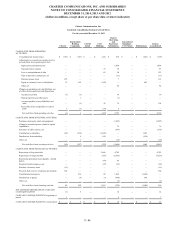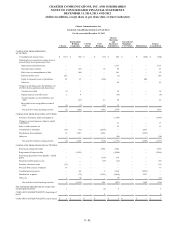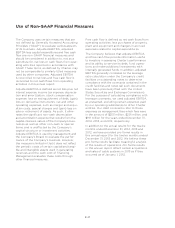Charter 2014 Annual Report Download - page 136
Download and view the complete annual report
Please find page 136 of the 2014 Charter annual report below. You can navigate through the pages in the report by either clicking on the pages listed below, or by using the keyword search tool below to find specific information within the annual report.The Company uses certain measures that are
not defined by Generally Accepted Accounting
Principles (“GAAP”) to evaluate various aspects
of its business. Adjusted EBITDA, adjusted
EBITDA less capital expenditures and free cash
flow are non-GAAP financial measures and
should be considered in addition to, not as a
substitute for, net loss or cash flows from oper-
ating activities reported in accordance with
GAAP. These terms, as defined by Charter, may
not be comparable to similarly titled measures
used by other companies. Adjusted EBITDA
is reconciled to net loss and free cash flow is
reconciled to net cash flows from operating
activities in this annual report.
Adjusted EBITDA is defined as net loss plus net
interest expense, income tax expense, deprecia-
tion and amortization, stock compensation
expense, loss on extinguishment of debt, (gain)
loss on derivative instruments, net and other
operating expenses, such as merger and acqui-
sition costs, special charges and (gain) loss on
sale or retirement of assets. As such, it elimi-
nates the significant non-cash depreciation
and amortization expense that results from the
capital-intensive nature of the Company’s busi-
nesses as well as other non-cash or special
items, and is unaffected by the Company’s
capital structure or investment activities.
Adjusted EBITDA is used by management and
the Company’s Board to evaluate the perfor-
mance of the Company’s business. However,
this measure is limited in that it does not reflect
the periodic costs of certain capitalized tangi-
ble and intangible assets used in generating
revenues and the cash cost of financing.
Management evaluates these costs through
other financial measures.
Free cash flow is defined as net cash flows from
operating activities, less purchases of property,
plant and equipment and changes in accrued
expenses related to capital expenditures.
The Company believes that adjusted EBITDA
and free cash flow provide information useful
to investors in assessing Charter’s performance
and its ability to service its debt, fund opera-
tions and make additional investments with
internally generated funds. In addition, adjusted
EBITDA generally correlates to the leverage
ratio calculation under the Company’s credit
facilities or outstanding notes to determine
compliance with the covenants contained in the
credit facilities and notes (all such documents
have been previously filed with the United
States Securities and Exchange Commission).
For the purpose of calculating compliance with
leverage covenants, we used adjusted EBITDA,
as presented, excluding certain expenses paid
by our operating subsidiaries to other Charter
entities. Our debt covenants refer to these
expenses as management fees which fees were
in the amount of $253 million, $201 million, and
$191 million for the years ended December 31,
2014, 2013, and 2012, respectively.
In addition to the actual results for the twelve
months ended December 31, 2014, 2013 and
2012, we have provided pro forma results in
this annual report for the twelve months ended
December 31, 2013 and 2012. We believe these
pro forma results facilitate meaningful analysis
of the results of operations. Pro forma results
in this annual report reflect certain acquisitions
and sales of cable systems in 2013 as if they
occurred as of January 1, 2012.
F-47
Use of Non-GAAP Financial Measures


















